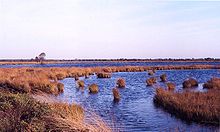Bog eye

A Moor eye ( English bog pond ) is in the center of rain or kettle bogs , formerly also in strong growing flow through bogs lying water collection that, or just as Hochmoorkolk Moorkolk Kolk is called. They owe their existence to the growth of the bog and are therefore of biogenic origin. The brown bog eyes are surrounded on all sides by bog or peat and get their water exclusively from the precipitation or from the large rain storage area raised bog. Such pools generally represent the non-evaporating excess moisture of a bog. The central waters of the bogs hardly show any silting processes .
If nutrients are enriched , vibrating lawns can form. They differ from other structures of the respective bog in their vegetation. Usually the ridge edges are somewhat richer in nutrients due to waves and wind effects and thus stronger mineralization processes . Trees such as downy birch ( Betula pubescens ) and other plant species such as B. the pipe grass ( Molinia caerulea ) settle, which is otherwise missing on the central areas of intact moors. The moor water is brown, poor in nutrients, rich in humic acid and free of lime ( dystrophic ).
literature
- Fritz Overbeck : Botanical-geological moor studies. With special consideration of the moors of northwest Germany as sources for the history of vegetation, climate and settlement. Wachholtz, Neumünster 1975, ISBN 3-529-06150-6 .
- Michael Succow , Lebrecht Jeschke: Moors in the landscape. Origin, household, living world, distribution, use and maintenance of the moors. 2nd Edition. Deutsch, Thun et al. 1990, ISBN 3-87144-954-7 .